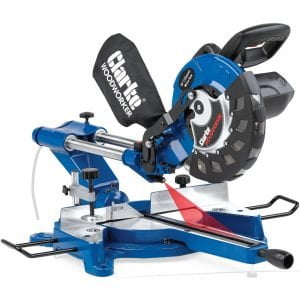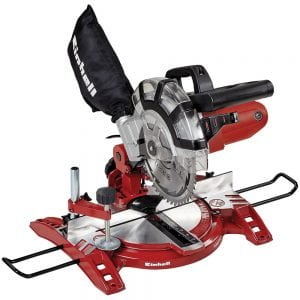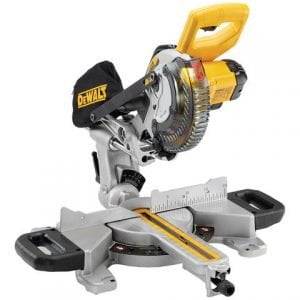Mitre saws are not difficult to understand once you learn what their basic differences are. A Mitre saw is basically a saw that sits on a fixed base, and a blade that is attached to an arm is able to pivot horizontally from 0 degrees to -45 or +45 degrees to accommodate the job.
To choose which features you want in your Mitre saw, it’s important to first know the differences between the three main types: standard, compound, and sliding compound saws.
Standard Mitre Saws
The advantage of a standard Mitre saw is that it’s perfect for basic Mitre cuts and doesn’t include all of the fancy features, which means you save a lot of money on the cost. If you’re looking for a basic Mitre saw that works great and that you can afford, this is it.
Standard Mitre saws tend to be lightweight as well, so you can easily move them from one location to another if you need to. They can also make cuts from -45 degrees to +45 degrees, so they are a very versatile type of Mitre saw.
Compound Mitre Saws
Compound cuts consist of bevelled cuts, which are sloped, and Mitre cuts, which are angled crosscuts, and the compound Mitre saw can handle both of them. Since you cannot use basic hand tools for compound cuts, Mitre saws offer the perfect solution when you wish to tilt the blade from 0 to 45 degrees either left or right.
Compound Mitre saws are more expensive than standard saws, so you’ll need to ask yourself if this feature is something you’ll need regularly before you rush out and buy one.
Sliding Compound Mitre Saws
With sliding compound Mitre saws, the arm isn’t fixed in place, but instead, the arm and the blade fit to a sliding mechanism. This results in the ability to move up and down, in and out, which can double or even triple your cutting capacity.
When it comes to additional features, sliding compound Mitre saws have the most features of any type of Mitre saw, which means they are a little more expensive than the rest of them. However, if you need to make both Mitre and bevel cuts and slide in and out on a regular basis, you won’t need to worry about the cost because this type of Mitre saw will be well worth it in the end.
 In addition to these basic types of Mitre saws, there are also variations available with each of them. Stationary Mitre saws can make left and right Mitre cuts, but can only make bevel cuts in one direction. Sliding compound saws can move forward and backward on the rails, and the sliding dual compound Mitre saw is able to do everything all of the other saws can do, in addition to making bevel cuts to the right and to the left.
In addition to these basic types of Mitre saws, there are also variations available with each of them. Stationary Mitre saws can make left and right Mitre cuts, but can only make bevel cuts in one direction. Sliding compound saws can move forward and backward on the rails, and the sliding dual compound Mitre saw is able to do everything all of the other saws can do, in addition to making bevel cuts to the right and to the left.
If you’ve ever asked yourself, can Mitre saws cut metal?, the answer is yes, they can. However, you need a special blade that is made specifically for this purpose; otherwise, the task will be futile. If you don’t want to ruin your tools and accessories while operating your Mitre tool, you must make sure you get the right type of blade for the job.
In addition to the basic types of Mitre saws, there are aspects of each type that you need to take into consideration, especially if you’re buying a Mitre saw for the very first time. Below are just a few of these aspects.
The Blade and the Crosscut Ability
If you’re cutting something wide like molding or need a bigger crosscut, bevel, or Mitre capacity, you may need to go beyond the traditional sizes of blades. Traditionally, Mitre blades are made in either 8.25, 8.5, 10, or 12 inches in diameter. It’s best to keep in mind that wider jobs need wider blades, so don’t choose an 8.25-inch blade for cutting dimensional lumber.
The TPI – teeth per inch – also makes a difference when you’re cutting hardwoods or wish to make a nice clean cut. Remember, the higher the TPI number the finer the blade and, therefore, the finer the final job will be. You also have to change the blades when they start to get dull, because nothing can be as frustrating as working with a dull Mitre blade.
The 10-inch blades can also be interchangeable with a table saw, providing an advantage over smaller blades. As long as you don’t mind swapping your table and Mitre saw blades, you won’t need two sets of blades to do the job. This can save you both time and money in the long run.
The Manufacturer of the Mitre Saw
 Like all other products, Mitre saws are made by a variety of manufacturers, but as long as you stick with a brand that is reputable, you should be able to rely on that particular saw to do the job you need it to do. Einhell Mitre saws, for example, are made in Europe and offer excellent tools at reasonable prices. On the other hand, Ryobi Mitre saws offer the unique option of a Mitre saw that is cordless and battery-operated.
Like all other products, Mitre saws are made by a variety of manufacturers, but as long as you stick with a brand that is reputable, you should be able to rely on that particular saw to do the job you need it to do. Einhell Mitre saws, for example, are made in Europe and offer excellent tools at reasonable prices. On the other hand, Ryobi Mitre saws offer the unique option of a Mitre saw that is cordless and battery-operated.
Below are a few of the advantages to each brand of Mitre saws:
- Evolution Mitre saws: perfect for both DIYers and professionals, these Mitre saws are both very powerful and technologically advanced
- The Lumberjack Mitre saw: allows you to complete most sawing jobs and is a great value for the money
- Makita Mitre saws: have been around since the 1960s and are associated with very high-quality tools; they are so well-made that it is mostly professionals who use them
- Dewalt Mitre saws: used by thousands of construction companies all over the world, these saws are made by the same company that makes other high-quality power tools
- Metabo Mitre saws: makes all types of Mitre saws and blades, which means they can handle even the most complex cutting job
- VonHaus Mitre saws: this company isn’t a household name, yet their Mitre saws are used by both amateurs and professionals alike, and their reviews speak for themselves
- Bosch Mitre saws: made mostly for DIY enthusiasts, these are well-made, durable Mitre saws that get great reviews every time
Consider the Power Source
For the most part, Mitre saws come with 10-, 12-, or 15-amp motors, but today some companies also offer cordless options that are operated by batteries. The cordless Mitre saws are lightweight, small, and are perfect for punch-list items or medium-duty tasks. They also generally have brushless motors that make them low-maintenance and long-lasting devices.
Makita is one of the many manufacturers that offer cordless Mitre saws for both DIY enthusiasts and professionals.
Your Cut Guide
In many of today’s Mitre saws, a red laser light is used to show you exactly where to cut, but as efficient as this sounds, it is not always foolproof. The red light can be hard to see, and since the diode isn’t tied to the blade, the line can be off by as much as 1/8”, which is significant for most projects.
If you still want a laser cut guide, try finding a Mitre saw that offers a green light instead of a red one. They are easier to see and can help you cut your wood in the right spot every time. You also have the option of products that use an LED light. LED lights are useful because there is always a shadow accompanying it, making it easy to see where to cut even if the light itself goes out.
Do You Need a Dust Extractor?
Sawdust is unpleasant because not only is it slippery, but it can also be unsafe to breathe. If you want to keep sawdust as far away as possible, you need a dust extractor. This is a type of vacuum that you attach to the Mitre saw, and it is particularly important if you are doing your cutting inside of a shop, garage, or at your customer’s place of business.
Remember, these dust extractors aren’t just for keeping the room a lot neater and cleaner; they are also to keep everyone in that room a little healthier.
Look for Various Accessories and Options
Like most products, Mitre saws can come with different optional features and even some accessories that you’ll eventually learn you can’t live without. This includes an arm lock meant to mobilize the blade’s up-and-down motion, built-in clamps that hold the material in place as you work, and of course, stands that offer a wide variety of sizes and designs.
Once you determine what type of work you’ll be doing most often, it is easy to figure out which type of Mitre saw you need. The smartest option is to do your due diligence so that you can find a Mitre saw that suits your needs, making it less likely that you’ll regret buying the one you did. Mitre saws come in many different types, purposes, and price ranges, so it shouldn’t be difficult to find the one that can best accommodate you.





